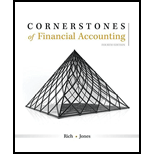
Expenditures After Acquisition
Pasta, a restaurant specializing in fresh pasta, installed a pasta cooker in early 2017 at a cost of $12,400. The cooker had an expected life of 5 years and a residual value of $900 when installed. As the restaurant’s business increased, it became apparent that renovations would be necessary so the cooker’s output could be increased. In January 2020, pasta $8,200 to install new heating equipment and $4,100 to add pressure-cooking capability. After these renovations, Pasta estimated that the remaining useful life of the cooker was 10 years and that the residual value was now $1,500.
Required:
1. Compute 1 year’s straight-line
2. Assume that 3 full years of straight-line depreciation expense had been recorded on the cooker before the renovations were made. Compute the book value of the cooker immediately after the renovations were made.
3. Compute 1 year’s straight-line depreciation expense on the renovated cooker.
Want to see the full answer?
Check out a sample textbook solution
Chapter 7 Solutions
Cornerstones of Financial Accounting
 Cornerstones of Financial AccountingAccountingISBN:9781337690881Author:Jay Rich, Jeff JonesPublisher:Cengage Learning
Cornerstones of Financial AccountingAccountingISBN:9781337690881Author:Jay Rich, Jeff JonesPublisher:Cengage Learning Financial Accounting: The Impact on Decision Make...AccountingISBN:9781305654174Author:Gary A. Porter, Curtis L. NortonPublisher:Cengage Learning
Financial Accounting: The Impact on Decision Make...AccountingISBN:9781305654174Author:Gary A. Porter, Curtis L. NortonPublisher:Cengage Learning Intermediate Accounting: Reporting And AnalysisAccountingISBN:9781337788281Author:James M. Wahlen, Jefferson P. Jones, Donald PagachPublisher:Cengage Learning
Intermediate Accounting: Reporting And AnalysisAccountingISBN:9781337788281Author:James M. Wahlen, Jefferson P. Jones, Donald PagachPublisher:Cengage Learning EBK CONTEMPORARY FINANCIAL MANAGEMENTFinanceISBN:9781337514835Author:MOYERPublisher:CENGAGE LEARNING - CONSIGNMENTPrinciples of Accounting Volume 1AccountingISBN:9781947172685Author:OpenStaxPublisher:OpenStax College
EBK CONTEMPORARY FINANCIAL MANAGEMENTFinanceISBN:9781337514835Author:MOYERPublisher:CENGAGE LEARNING - CONSIGNMENTPrinciples of Accounting Volume 1AccountingISBN:9781947172685Author:OpenStaxPublisher:OpenStax College





